Visual tactics are common means of driving feral birds away from a property. Homeowners and establishment occupants both utilize these methods. Using visual scare for birds work most of the time, but for some, the supposedly efficient tool becomes less useless. Some aspects play here including the type of birds you’re intending to get rid of and how consistent you are in using these products.
There are many means of repelling birds. Some use irritating sounds or sticky gels but there is a bigger disadvantage with this. There’s no guarantee that the sound device will work all the time plus the gel might get stuck small birds and kill them in process. This is the reason why many property owners resort to visual tactics. The likes of gardens and porches have some aesthetic attachments to it that can be preserved through scare products.
1. You have to move it, move it!
Visual scares work its magic but you have to move it all regularly. This is so the feral birds like pigeons and crows won’t detect that it’s nothing but a fake predator. Crows are very smart birds and they can easily recognize if a visual scare has been in the same place for a period of time. As the birds grow accustomed to the placement of your scares, they will soon outgrow the fear.
So if you have a fake owl decoy in the porch, move it to your garden, then the fence, or the roof.
2. The right decoy for the right birds
Using visual scare for birds may not work for all cases of bird invasion. For example, a decoy snake may not scare an owl or a gull. What you need might be shiny tapes or scare sounds of bigger predators directly feared by the species pestering your property.
Getting the right decoy for the right birds will make the bird proofing easier. Also, you wouldn’t need to spend much money trying each product out. You don’t have to fret since there are visual scares that target the majority of feral birds.

3. You have to be consistent
Consistency is your defense against invasive birds like crows and pigeons. These species tend to be aggressive in the sight of a food source so you have to step up your game. Move that owl scare every day or after a few hours if you can. You should also replace fading tapes where you attach it to make sure that the scare level stays in the maximum possible level.
Managing those scares every day could be a demanding task, but trust me, when you’re out of words on your yard, you’re going to thank yourself.
4. Don’t stick to one
Using visual scare for birds is a practical and economical move but you should incorporate more than one method to succeed. You have to up the ante of your defense especially if the birds visiting you are ravenous and monster peckers. You can blend scare tapes and shiny discs for added blinding effect. Also, you can use scare balls and scarecrows on larger fields and gardens or vegetable beds where the birds feed on.
By using multiple scares, the feral birds are less likely to recognize that your tactics are all decoys. The more baffling and disorienting, the better.
5. Make it harmless
Of course, visual scares are always harmless for the birds. In case you’re thinking of blowing the birds off when they ignore the decoys, think twice before doing so. Keep in mind that there are protected birds under the federal law, and if you kill them, you will face fines and potential jail time. Even if you don’t intend to harm or kill the fowl, any wrongful death due to your repelling methods can put you in tangles with the law.
As much as possible, stick to your visual tactics and make it work. It will need patience but using visual scare for birds is safer for you and the fowls.

6. Explore the methods
If one trick didn’t work, don’t stop and try another one. Sometimes, bird species can be a pain in the ass to drive away. It will test your patience but remember that there are tons of visual repellers out there for you to utilize. See which one works for you and which one doesn’t. Remember that each product out there works in a specific scenario. If it didn’t work its magic for you, it doesn’t mean that it’s a dud. Sometimes, some birds are just too desensitized to common visual scares that they are no longer fazed by it.
7. Maintenance is important
Are your owl decoy’s eyes already faded? Are your scare tapes torn and losing its shimmer? If this is the status of your visual methods, take time to do some maintenance work. The owl decoy might need some cleaning or repainting or the tapes have to be replaced. Keeping up with the efficiency of the scares will keep the pesky birds at bay.
Some scares are meant to last for a long time but don’t be too complacent about these marketing claims. Check the apparatus from time and time and see what needs changing.
8. Get the best product
Like what I said earlier, there are tons of products in the market made for scaring birds. However, the important part here is getting the piece that actually works. Look for reviews and referrals. Chances are you’re going to find some testimonies that you can relate to and see if a certain product worked for them.
Another tip is purchase scares from sellers that give a money-back guarantee and some sort of warranty if their product didn’t work.
If you’re using visual scare for birds, you might as well practice the tactics I discussed above. All of it will make every product work at its best so your money won’t go to waste. Do you have something to add on this post? Let us know below!



